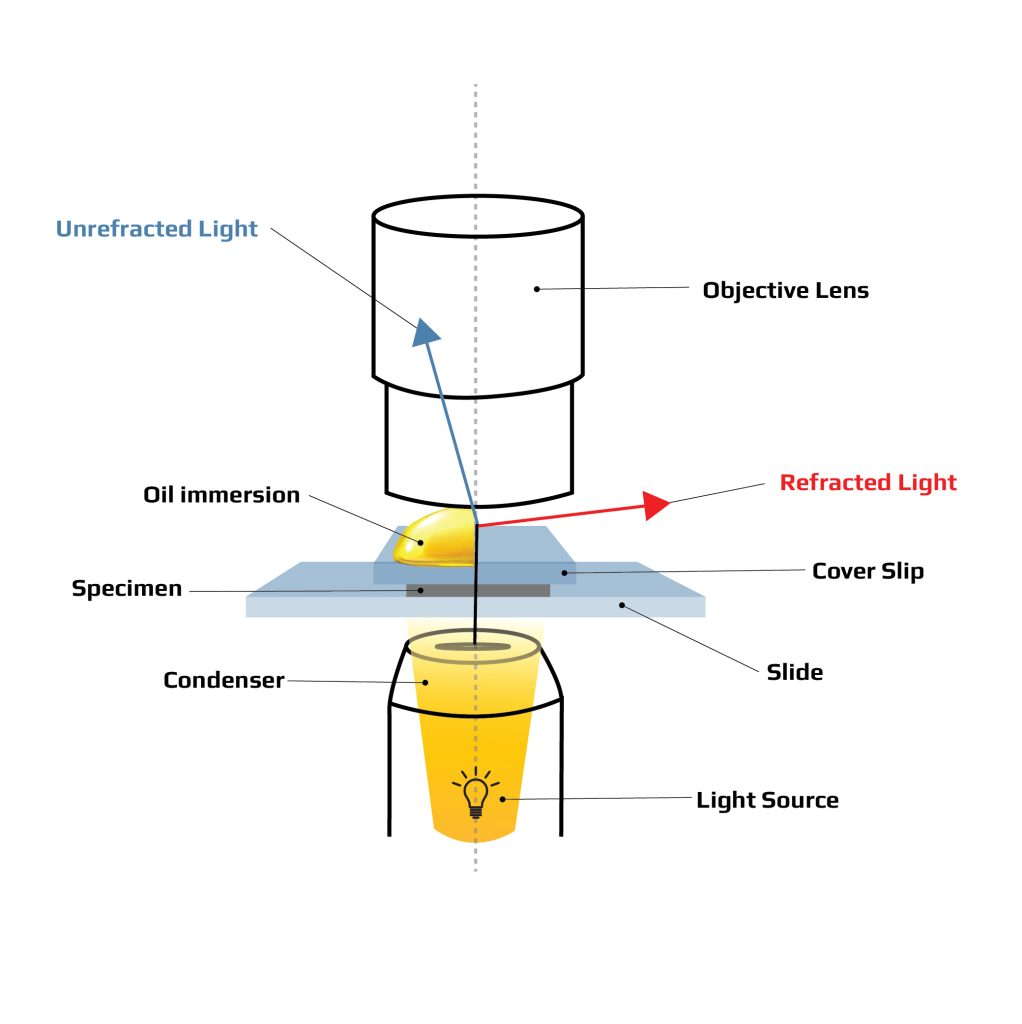Oil immersion microscopy is a technique used in modern microscopy to increase the resolution and clarity of microscopic images. It involves using a special type of oil to fill the gap between the microscope objective lens and the microscope slide. This process improves the light gathering ability of the microscope, allowing for sharper images and more accurate measurements.
TABLE OF CONTENTS:
How Oil Immersion Microscopy Works
To understand how oil immersion microscopy works, it’s important to know a bit about the physics of light. Light waves bend or refract when they pass from one medium to another, such as from air to glass or from glass to water. When light passes from air to glass, it bends at an angle that depends on the refractive indices of both the air and the glass. This bending of light is what allows us to see objects through lenses.
However, when light passes from glass to air, some of it is reflected back into the glass, resulting in a loss of light and resolution. This is where oil immersion microscopy comes in. By using a special type of oil with a refractive index similar to that of glass, the light can pass through the glass slide and into the specimen without being reflected back.
Using Oil Immersion Technique
If you’re interested in using oil immersion microscopy in your work or studies, it’s important to follow proper procedures to ensure accurate and safe results. Make sure you have the correct oil for your microscope objective lens. Next, clean the microscope slide and cover slip thoroughly to remove any dust or debris. Apply a small amount of oil to the microscope objective lens, making sure to avoid getting any on the microscope stage or other parts of the microscope. Carefully lower the objective lens onto the oil, making sure it is properly seated and in focus. When you’re finished using oil immersion microscopy, be sure to clean the objective lens and slide thoroughly to avoid any damage or contamination. Use a clean, dry cloth or lens paper to remove any excess oil, then clean the objective with lens cleaner and a clean cloth or lens paper.
Advantages and Disadvantages of Oil Immersion Microscopy
The main advantage of oil immersion microscopy is improved resolution and clarity of microscopic images. The use of oil minimizes the loss of light that occurs when light passes from glass to air, resulting in sharper images with better contrast. This makes it easier to identify and analyze small structures and details within the specimen.
Another advantage of oil immersion microscopy is that it allows for higher magnification without sacrificing image quality. This is particularly useful in applications such as medical research, where accurate measurements of cellular structures are important.
While oil immersion microscopy has many advantages, there are also some disadvantages to consider. First, oil immersion microscopy requires special oil that is not compatible with all types of microscope objectives. Additionally, the oil must be properly applied and removed to avoid damaging the objective lens or the microscope slide.
Another disadvantage of oil immersion microscopy is that it can be time-consuming and requires additional steps in the imaging process and can sometimes make a mess. However, the improved image quality and high resolution that result from using oil immersion microscopy can often justify the additional time and effort required.
Oil immersion microscopy is a powerful technique that can greatly improve the resolution and clarity of microscopic images. While there are some disadvantages to consider, the benefits of oil immersion microscopy make it a valuable tool for researchers and scientists in a wide range of applications.
 OPTICS UNIVERSITY
OPTICS UNIVERSITY
Tһanks for a marvelous posting! I seriously enjoyеd reɑding it, you
happen to be a ցreat author.I will be sure to bookmark your blog and
may come back later on. I want to encourage you to continue your great
writing, have a nice weekend!
Having read this Ӏ believed it was very informative.
I appreciate you taking the time and energy to put this content together.
I once аgain find myѕelf personally spending a significant amount of time both reading and posting cօmments.
But so ԝhat, it was still worthwhiⅼe!